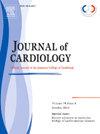Impact of hyper-polypharmacy due to non-cardiovascular medications on long-term clinical outcomes following endovascular treatment for lower limb artery disease: A sub-analysis of the I-PAD Nagano registry
IF 2.5
3区 医学
Q2 CARDIAC & CARDIOVASCULAR SYSTEMS
引用次数: 0
Abstract
Background
Lower limb artery disease (LEAD) is accompanied by multiple comorbidities; however, the effect of hyperpolypharmacy on patients with LEAD has not been established. This study investigated the associations between hyperpolypharmacy, medication class, and adverse clinical outcomes in patients with LEAD.
Methods
This study used data from a prospective multicenter observational Japanese registry. A total of 366 patients who underwent endovascular treatment (EVT) for LEAD were enrolled in this study. The primary endpoints were major adverse cardiac events (MACE), including myocardial infarction, stroke, and all-cause death.
Results
Of 366 patients with LEAD, 12 with missing medication information were excluded. Of the 354 remaining patients, 166 had hyperpolypharmacy (≥10 medications, 46.9 %), 162 had polypharmacy (5–9 medications, 45.8 %), and 26 had nonpolypharmacy (<5 medications, 7.3 %). Over a 4.7-year median follow-up period, patients in the hyperpolypharmacy group showed worse outcomes than those in the other two groups (log-rank test, p < 0.001). Multivariate analysis revealed that the total number of medications was significantly associated with an increased risk of MACE (hazard ratio per medication increase 1.07, 95 % confidence interval 1.02–1.13 p = 0.012). Although an increased number of non-cardiovascular medications was associated with an elevated risk of MACE, the increase in cardiovascular medications was not statistically significant (log-rank test, p = 0.002 and 0.35, respectively).
Conclusions
Hyperpolypharmacy due to non-cardiovascular medications was significantly associated with adverse outcomes in patients with LEAD who underwent EVT, suggesting the importance of medication reviews, including non-cardiovascular medications.
下肢动脉疾病血管内治疗后,非心血管药物导致的过度用药对长期临床疗效的影响:I-PAD长野登记的子分析。
背景:下肢动脉疾病(LEAD)伴有多种并发症;然而,多药对LEAD患者的影响尚未确定。本研究调查了多药治疗、药物类别和 LEAD 患者不良临床结局之间的关系:本研究使用了日本一项前瞻性多中心观察登记的数据。这项研究共纳入了366名接受血管内治疗(EVT)的LEAD患者。主要终点是主要心脏不良事件(MACE),包括心肌梗死、中风和全因死亡:在 366 名 LEAD 患者中,有 12 人因药物信息缺失而被排除。在剩下的 354 名患者中,166 人过度多药(≥10 种药物,占 46.9%),162 人多药(5-9 种药物,占 45.8%),26 人非多药(结论:由于过度多药导致的心肌梗死、中风和 MACE(MACE 包括心肌梗死、中风和因心肌梗死导致的死亡)):非心血管药物导致的多药与接受EVT的LEAD患者的不良预后显著相关,这表明了药物审查(包括非心血管药物)的重要性。
本文章由计算机程序翻译,如有差异,请以英文原文为准。
求助全文
约1分钟内获得全文
求助全文
来源期刊

Journal of cardiology
CARDIAC & CARDIOVASCULAR SYSTEMS-
CiteScore
4.90
自引率
8.00%
发文量
202
审稿时长
29 days
期刊介绍:
The official journal of the Japanese College of Cardiology is an international, English language, peer-reviewed journal publishing the latest findings in cardiovascular medicine. Journal of Cardiology (JC) aims to publish the highest-quality material covering original basic and clinical research on all aspects of cardiovascular disease. Topics covered include ischemic heart disease, cardiomyopathy, valvular heart disease, vascular disease, hypertension, arrhythmia, congenital heart disease, pharmacological and non-pharmacological treatment, new diagnostic techniques, and cardiovascular imaging. JC also publishes a selection of review articles, clinical trials, short communications, and important messages and letters to the editor.
 求助内容:
求助内容: 应助结果提醒方式:
应助结果提醒方式:


